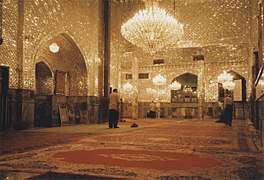Imamzadeh
An Imāmzādeh (Persian: امامزاده) refers to an immediate descendant of a Shi'i Imam in the Persian language. This Persian term is also used in Urdu and Azeri.


_2.jpg)
Imamzadeh means "offspring" or descendant of an imam. There are many other different ways of spelling this term in the English language.[1] Some of these are imamzada, imamzadah, and emamzadah.[2][3] These all have the same meanings. Imamzadeh are basically the Syed's or Syeda's as they have descended from the Imams.
Imamzadeh is also a term for a shrine-tomb of the descendants of Imams, who are directly related to Muhammad.[1] These shrines are only for the descendants of imams and they are not for imams themselves. Imamzadehs are also sayyids, though not all sayyids are considered imamzadehs.[4] These shrine-tombs are used as centers of Shi’i devotion and pilgrimages. These shrine-tombs are also believed to have miraculous properties and the ability to heal.[5] Many of these are located in Iraq, Medina, India and Iran.
There are many important imamzadehs. Two of these are Fātimah bint Mūsā, the sister of Imam Ali al-Ridha, the eighth Twelver Imam, and Zaynab bint Ali, daughter of Ali, considered by Shi'i Muslims to be the first Imam and by Sunni Muslims as the fourth Rashid. Imamzadehs are not traditionally women.[6]
Many people visit the imamzadehs that are relatively close to them. There are also special ziyarat-namas (pilgrimages) for many of the imamzadehs. Some of these pilgrimages even happen annually during the certain time of year.[7] Some of the imamzadehs are not as well kept as others. According to Reinisch an imamzadeh that he saw was mostly in ruins, though it is still important.[8]
Imamzadehs
- Imamzadeh Hamzah, Tabriz
- Imamzadeh Ja'far, Borujerd
- Imamzade Ja'far and Muhammed, Damghan
- Imamzadeh Saleh, Shemiran
- Imamzadeh Sultan Mutahhar
- Sultan Ali at Mashhad-e Ardehal
- Shah-Abdol-Azim shrine
- Shah Cheragh
- Imamzadeh (Ganja)
- Emamzadeh Ahmad
- Emamzadeh Esmaeil, Isfahan
- Emamzadeh Haroun-e-Velayat
- Emamzadeh Jafar
- Emamzadeh Shah Zeyd
- Imamzadeh Hossein
References
- Esposito, John L. 2003. The Oxford Dictionary of Islam. Oxford University Press. Oxford. p 136.
- Glasse, Cyril. 2001. The Concise Encyclopedia of Islam. Revised Edition. Stacey International, London. Page 213
- Lambton, A.K.S. "Imamzada." Encyclopedia of Islam, Second Edition. Edited by: P. Bearman, Th. Bianquis, C.E. Bosworth, E. Van Donzel and W.P. Heinrichs. Brill, 2010. Brill Online. Augustana. 6 April 2010 <http://www.brillonline.nl/subscriber/entry?entry=islam_SIM-3552>
- Lambton, A.K.S. "Imamzada." Encyclopedia of Islam, Second Edition. Edited by: P. Bearman, Th. Bianquis, C.E. Bosworth, E. Van Donzel and W.P. Heinrichs. Brill, 2010. Brill Online. Augustana. 6 April 2010 <http://www.brillonline.nl/subscriber/entry?entry=islam_SIM-3552>
- Esposito, John L. 1995. The Oxford Encyclopedia of the Modern Islamic World, v.2. Oxford University Press. Oxford. Page 185
- Lambton, A.K.S. "Imamzada." Encyclopedia of Islam, Second Edition. Edited by: P. Bearman, Th. Bianquis, C.E. Bosworth, E. Van Donzel and W.P. Heinrichs. Brill, 2010. Brill Online. Augustana. 6 April 2010 <http://www.brillonline.nl/subscriber/entry?entry=islam_SIM-3552>
- Lambton, A.K.S. "Imamzada." Encyclopedia of Islam, Second Edition. Edited by: P. Bearman, Th. Bianquis, C.E. Bosworth, E. Van Donzel and W.P. Heinrichs. Brill, 2010. Brill Online. Augustana. 6 April 2010 <http://www.brillonline.nl/subscriber/entry?entry=islam_SIM-3552>
- Reinisch, Leo. "Egypt and Abyssinia". The Geographical Journal, Vol. 9, No. 3 (Mar., 1897), Blackwell Publishing on behalf of The Royal Geographical Society (with the Institute of British Geographers) <https://www.jstor.org/stable/1774943>. pp. 314-318.

